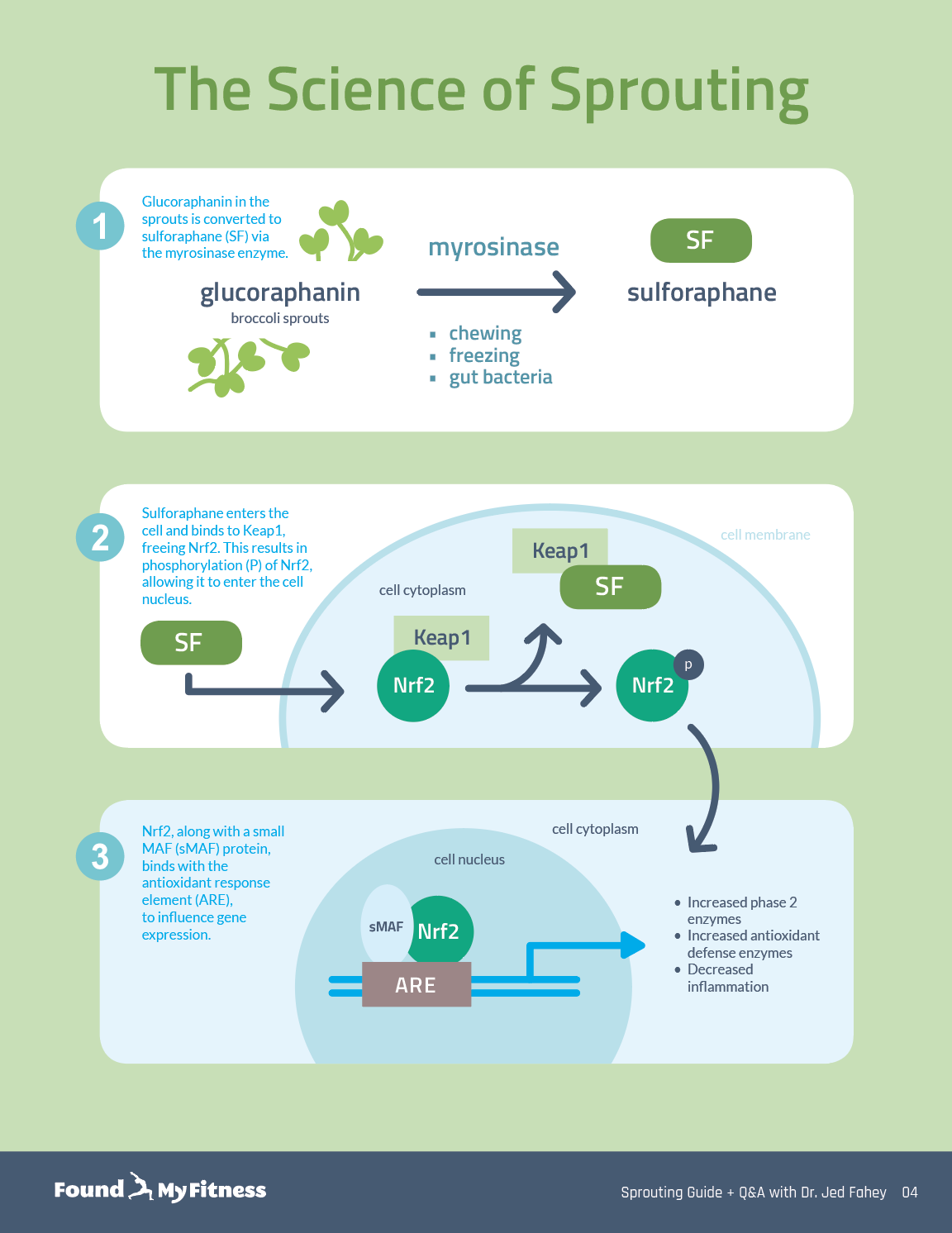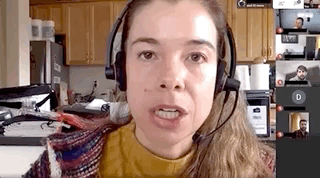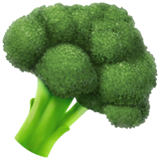NRF2 pathway as the mechanism behind sulforaphane’s protective effects | Jed Fahey
Enter your email to get our 15-page guide to sprouting broccoli and learn about the science of chemoprotective compount sulforaphane.
Broccoli sprouts are concentrated sources of sulforaphane, a type of isothiocyanate. Damaging broccoli sprouts – when chewing, chopping, or freezing – triggers an enzymatic reaction in the tiny plants that produces sulforaphane.

Get the full length version of this episode as a podcast.
This episode will make a great companion for a long drive.
The 1992 discovery of sulforaphane, a compound derived from broccoli and broccoli sprouts, paralleled the discovery of Nrf2, a cellular protein that participates in the Keap1-Nrf2-ARE biological pathway. Nrf2 regulates the expression of cytoprotective proteins that protect against oxidative stress due to injury and inflammation. Sulforaphane is the most potent naturally occurring inducer of Nrf2. In this clip, Dr. Jed Fahey describes the early co-discoveries of sulforaphane and Nrf2, and describes the importance of the Nrf2 pathway.
Rhonda: And one of those, I guess, one of the main protective mechanisms would be the Nrf2 pathway.
Jed: Yeah. So I have a feeling that sulforaphane would be just be another interesting phytochemical if at almost the same time, we, and I use the term "we" loosely because I was only very peripherally involved with this. But a number of people at Johns Hopkins and in Japan discovered, in Japan and England, I should say, but a small number of people discovered this Nrf2 pathway and really fleshed out all the details of it. And this happened in parallel to the interest in sulforaphane and broccoli.
And it turns out that the Nrf2 pathway is an extremely important pathway for up-regulating the protective enzymes and protective proteins including perhaps the heat shock proteins in cells so that they can protect themselves against various insults. It's an integral part of protection against a variety of chronic diseases. And as I say, Tom Kensler and Paul Talalay, Albena Dinkova-Kostova all at Hopkins, Masi Yamamoto in Japan, John Hayes in England, excuse me, and I'm certainly leaving out a few people, but small number of people initially put this pathway on the map. And it turns out that the Nrf2 pathway controls something between 3% and 5% of our cellular proteins. So it's very important.
Rhonda: Wow. I didn't realize it's that much.
Jed: Yeah. And why is it important? It's important because it recognizes molecules like sulforaphane through a system, a biochemical system that I hesitate to explain without props and graphs, and also because I'm not the world's expert on this, certainly. But it recognizes sulforaphane or other similar molecules as they enter cells in the cytoplasm of the cells. Then there's actually a chaperone protein that's in the cytoplasm. It's called Keap1. That molecule when it binds to sulforaphane, or vice versa, changes in conformation and it releases Nrf2, which then migrates to the nucleus and turns on or up-regulates the antioxidant response element which is responsible for the transcription, for initiating transcription of a whole series of protective genes or genes in coding for a bunch of protective enzymes.
And this happens very quickly, this protective response, and it's quite efficient. So to get back to sulforaphane, so sulforaphane was discovered and then everybody started searching for the mechanism by which it acted. The Keap1-Nrf2 mechanism was discovered, and they sort of both developed a following, if you will, in parallel. And it turns out that sulforaphane is still probably the most potent activator of Nrf2 to be found naturally in from the natural world. There have been synthetic activators that are more potent, that have been produced, been made chemically, but sulforaphane still sort of takes the cake in terms of its protective ability, and ability to up-regulate protective enzymes.
A molecule that inhibits oxidative damage to DNA, proteins, and lipids in cells. Oxidative damage plays a role in the aging process, cancer, and neurodegeneration. Many vitamins and plant-based compounds are antioxidants.
Any of a group of complex proteins or conjugated proteins that are produced by living cells and act as catalyst in specific biochemical reactions.
A family of proteins produced by cells in response to exposure to stressful conditions. Heat shock proteins are expressed in response to heat as well as exposure to cold and UV light, and during wound healing and tissue remodeling. Many heat shock proteins function as chaperones by stabilizing new proteins to ensure correct folding or by helping to refold proteins that were damaged by cell stress. A 30-minute 73ºC sauna session in healthy young adults has been shown to cause a robust and sustained increase in the production of heat shock proteins for up to 48 hours afterward.[1]
- ^ Shields, Richard K; Iguchi, Masaki; Littmann, Andrew E.; Chang, Shuo-Hsiu; Wester, Lydia A.; Knipper, Jane S. (2012). Heat Stress And Cardiovascular, Hormonal, And Heat Shock Proteins In Humans Journal Of Athletic Training 47, 2.
A protein typically present in the cytoplasm of mammalian cells. Nrf2 can relocate to the nucleus where it regulates the expression of hundreds of antioxidant and stress response proteins that protect against oxidative damage triggered by injury and inflammation. One of the most well-known naturally-occurring inducers of Nrf2 is sulforaphane, a compound derived from cruciferous vegetables such as broccoli.
Highly reactive molecules that have the ability to oxidize other molecules and cause them to lose electrons. Common oxidants are oxygen, hydrogen peroxide, and superoxide anion.
An isothiocyanate compound derived from cruciferous vegetables such as broccoli, cauliflower, and mustard. Sulforaphane is produced when the plant is damaged when attacked by insects or eaten by humans. It activates cytoprotective mechanisms within cells in a hormetic-type response. Sulforaphane has demonstrated beneficial effects against several chronic health conditions, including autism, cancer, cardiovascular disease, diabetes, and others.
Attend Monthly Q&As with Rhonda
Support our work

The FoundMyFitness Q&A happens monthly for premium members. Attend live or listen in our exclusive member-only podcast The Aliquot.
Sulforaphane News
- Broccoli seed extract with a sulforaphane precursor reduced common cold symptom days in healthy adults.
- Sulforaphane-rich broccoli sprout extract modestly lowers fasting blood sugar in some people with prediabetes, perhaps due to variations in gut microbiota and individual metabolic traits.
- Sulforaphane, derived from broccoli, activates Nrf2, mitigating age-related skin changes and boosting the antioxidant defense system in mice.
- Sulforaphane from broccoli sprouts shows promise in preventing Alzheimer's disease – boosting memory and enhancing mitochondrial function in mice.
- Breathwork enhances endogenous antioxidant enzyme activity to counter oxidative stress.





